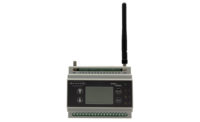From the 1970s up until roughly the end of the century, centralized programmable logic controllers were the center of attention when it came to driving improvements in automation. Uniformity and repeatability were the name of the game. Back then, software and communication protocols were a common differentiator to measure the effectiveness of automation. The key benefits of these systems were to establish higher levels of uniformity and efficiency in the processes themselves.
Sensors were an integral part of these systems, but their role was limited compared to their role today. They basically communicated to their host PLC that something happened. For example, “The engine block is here. The hole is drilled. The drill is retracted.”
Today, the role of sensors has vastly changed. Sensors do a lot more than just send a yes-no or on-off message to a PLC. Whether the production process is automatic or semiautomatic, sensors and radio frequency identification (RFID) technology are now driving the quality control process.
Error-proofing processes made possible by the clever application of sensors and RFID are as important as the overall logic and structure of the production processes. They provide vital data for the supply chain and are regarded as the most effective ways to reduce cost and improve processes. Sensors are the primary control components of an automated production system and can actually increase the quality of the product itself. Now, sensors can be used to tell a PLC how well things are happening and if the products and parts are within spec. Moreover, they provide this information as an integral part of each step in the manufacturing process, not just as an outmoded quality check.
Similarly, RFID—within and between islands of automation—provides a way of tracking not only what has happened, but what has gone right. RFID records where something has gone wrong, and what needs to be done to correct the problem. Manufacturing today is much more than building a quality product. The right product must be queued in the correct sequence and delivered at the right time—time after time.
While PLCs have a direct impact on overall process efficiency, sensors have a direct impact on product quality. Sensors have long proven their effectiveness in queuing basic automation tasks, but they are now increasingly being used for error-proofing. New technologies are enabling sensors to compete successfully with more advanced error-proofing devices, such as vision systems. Sensor-driven error-proofing, often in concert with RFID, provides a simple and effective means of ensuring that a part is present and in the correct orientation for processing.
Active error-proofing addresses common production concerns such as:
- Incorrect part installation (for example, wrong bolt size).
- Color mismatches (for example, wrong trim piece).
- Missing parts (for example, washer not installed).
- Insufficient fastening (for example, torque not adequate).
- Insufficient lubrication.
- Product mislabeling.
- Products delivered out of sequence.
Sensors provide standardized outputs that are either discrete (yes-no) or analog (measurement or position). Integrating active error-proofing involves determining the right use of sensors and the level of error-proofing required. Generally speaking, for sensors to work correctly, certain conditions have to be present. Parts need to be well-fixtured, either contained in a fixture, or able to be brought to an inspection station that can hold the required tolerances. There needs to be a manageable number of inspection points per part so that desired parameters can be verified by a reasonable number of sensors. Finally, the location of the detail on the part in question must remain in a constant position relative to the sensor.
Sensors in Assembly Applications
A wide range of sensor technologies are found in assembly automation.
Inductive proximity sensors are the foot soldiers of the sensor world. Relatively simple, discrete (on-off) devices, inductive proximity sensors can determine the presence or absence of a part or hole. They can also detect or confirm specific features. Inductive “proxes” are robust, stable in operation, reliable, and accurate. They can stand wide temperature ranges and are one of the easiest sensors to deploy. If the target to be detected is metal, an inductive prox is hard to beat.
Discrete photoelectric sensors are available in through-beam (energized pairs), retroreflective (used with a dependable target, a reflector) and diffuse reflective (self-contained emitter-receiver pair) modes. All can be used to detect the presence of metallic and nonmetallic components.
The most commonly used photoelectric sensors produce red, infrared or laser emissions. Which to use depends on the application. Laser sensors provide a more controlled and precise light beam. Red-light emitting sensors are easy to set up. Infrared emitters possess the greatest amount of excess gain, or the ability to sense through smoke, oils, mist or steam.
When a simple, fixed yes-no response is not enough for successful assembly, an analog sensor can provide the additional data essential for error-proofing. Analog sensors provide part position information in the form of an analog signal that interfaces directly with the control system, allowing both actual measurements and an infinite variability in yes-no decisions. In addition, some analog sensors offer one or more discrete outputs.
Analog sensors also provide a continuous voltage output for precise gauging, measuring and positioning of parts. Several models of both inductive and photoelectric technologies offer discrete set points that can be programmed anywhere in the sensing range of the sensor. This feature can help to establish “go-no-go” parameters, as well as position feedback, in a single sensor.
Laser-based sensors offer a higher level of precision, ease of use, and cost effectiveness in error-proofing applications. Laser sensors detect product details by using a diffuse technique, with or without background suppression. They can also operate like photoelectric sensors in through-beam or retroreflective modes. Beam-break versions are reliable, accurate and capable of long-range position detection without regard to target color. Through-beam sensors can error-proof product details either based on a missing part or part shape differentiation.
Easily seen laser spots assist operators by highlighting a specific product detail and are especially useful for informing the operator about error locations after detection. The long-range capability of lasers allows them to be positioned around operators or moving tooling, enabling more points of detection in smaller areas. In addition, the precision available from laser sensors is often far in excess of what the machine fixturing can provide. The better the machine tolerance, the better the laser performs in that operation.
Color sensors are used to verify that the right color of component was assembled on the right device. Color sensors come in a wide range of sophistication. On the low-cost end, easy-to-program sensors are available that can detect and store three colors, or shades of color, in memory. These solve 80 to 90 percent of the day-to-day color sensing requirements found in manufacturing processes.
True color sensors are perfect for highly specialized applications, such as color matching and in-line vehicle sequence verification in the automotive industry. In this case, color sensors are tuned to sense the difficult darker shades typically found in automotive interiors. These color sensors are able to learn three individual colors without the need for external lights or controllers. Setting the sensor is accomplished by teaching the intended color and then assigning a tolerance level to that color setting. Narrow tolerance levels allow detection of small shade differences, while widening the tolerance allows for acceptable shade variations due to color lot inconsistencies. Two decision modes are also available to handle shiny or matte surfaces.
UV tracing is the most reliable method of error-proofing complex assembly tasks—even better than a vision system. There are two steps in the UV tracing process. The first is to apply a luminescent tracer material to the parts. The second step is to use a UV sensor to detect the tracer material. When the sensor sees a certain level of luminosity from the tracer, the part has been positively identified.
The advantages of UV sensors include reliability, accommodation of loosely fixtured parts, the use of fiber optic cabling for tight locations, simple teach-in controls, and compatibility with any control system. The benefit is that target materials are invisible to the human eye, inert (no chemical reactions) and have no negative impact on product aesthetics. Many lubricants inherently “glow” when exposed to UV light. In fact, many engine test stand and power train manufacturers use UV sensors to detect leaks and overflow to determine fill levels in lubrication tests prior to installation.
Regardless of the sensor that is deployed, application expertise is crucial when it comes to effective operation. In fact, a less capable sensor deployed cleverly is often far more effective than a more powerful sensor poorly applied. Tubular, “flatpack” and block-style sensors in a wide range of geometric configurations are available to meet specific mechanical and electrical application requirements. This is where skilled machine operators, maintenance personnel, and sensor suppliers can make a vast difference in increasing product quality and assembly line efficiency. A close working relationship with your sensor supplier can pay dividends.
Sensor Protection
A major factor in downtime prevention is the protection of sensors from impact damage, and, in a weld cell environment, slag and heat. Once again, application expertise is the key to long sensor life. Impact causes more sensor wastage than all other factors combined. In fact, the vast majority of all premature sensor failures are caused by systemic or incidental impact.
If a sensor is in danger of being hit, there are five basic remedies:
- Use a more robust sensor.
- Use a smaller sensor with the same range.
- Use a different sensor with a longer range.
- Move the sensor out of the way.
- Protect the sensor using bunker blocks, prox mounts or other strategies.
Sensors and Welding Cells
Heat, especially heat found in weld cells, is a major problem, not just for sensors, but for their associated cables and connectors as well. Hot slag accumulation and elevated temperatures created by welding operations can degrade sensor performance and destroy unprotected wiring and connectors. Sensors and wiring will not last long if they are not protected.
As in all manufacturing processes, it’s critical to match the sensor to the application. To keep weld cells functioning properly, inductive proximity sensors used for nesting validation must be able to withstand the rigors of loading impact. Coated inductive proximity sensors resist accumulation of weld debris. They also facilitate debris removal during scheduled maintenance. Photoelectric sensors must have the capacity to sense through smoke and oily film (high excess is imperative). Clamping sensors must be able to handle heat, debris, shock and vibration. Everything must be properly bunkered, buried and sleeved to resist the harshest of conditions and to increase machine uptime.
Ironically, there are devices that meet these goals, yet they don’t always end up in a welding cell. Engineers would do well to remember that replacement of unprotected sensors can cost the average weld cell user between $6,000 and $64,000 per month, not counting maintenance and machine downtime.
Metal Forming Applications
The same error-proofing principles hold true for metal forming as they do for assembly automation applications. In addition to stamping perfect parts with zero defects, engineers would like to protect dies from damage, prevent die lock up, and run production without interruption.
The same sensing technologies used for assembly automation can also be used in metal forming, but for different purposes and applications.
Discrete sensors are used to monitor stripper position and strip feed, and to detect pilot holes and features. They can also be used for slug-out and parts-out sensing in dies, as well as to prevent double hits. Short-range analog sensors can measure bend angles on parts and other critical dimensions or features, and they can measure press parallelism. They are also used for part verification and parts detection on stand-alone error-proofing stations. Photoelectric sensors can be integrated to measure precise roll feed, parts out, and slug-out detection.
RFID in metal forming can ensure that correct die segments are in place. This protects dies from crashes in large systems before the stamping process occurs. RFID is also used for die identification and tracking, which is important for manufacturers that have hundreds of frequently used dies in house.
RFID in Error-Proofing
Today, manufacturers often need to assemble various product versions on the same production line. The salient features of each product must be identified, tracked and communicated. This is most effectively done by an RFID system that stores build data on a small data carrier affixed permanently to the build pallet.
Sensor-based RFID systems have proven especially useful in machining operations where data is included on pallets that move into and out of machining stations. Before processing begins, the data carrier is loaded with the information that will instruct all downstream processes how to make that exact part. Correct machining is verified by comparing the build information to what error-proofing sensors detect.
Build information can be kept decentralized on each pallet, held centrally in the control system, or acted on directly without intervention from the control system. These differences have a direct impact on the communication method required between the control system and the data carriers.
When build information is maintained and referenced centrally in the control system, a simple and economical parallel, read-only interface can be used. This 8-bit RFID interface connects directly to inputs on the control system, significantly reducing integration time. The control system can read the tag and pull up a virtual build sheet from a list stored in a data base.
During assembly, RFID helps manufacturers produce variants on the same line. Such RFID systems can be matched to the level of complexity required for the application. They can be simple “read-only,” 8-bit parallel systems, or they can be “read-write” systems. Build information is written to the data carrier before assembly begins. The assembly system reads the build information at each station to determine what assembly and error-proofing operations are required. If the assembly requires testing, the results of those tests can be loaded into the data carrier for subsequent archiving. These systems can read and write data using many standard protocols, including ProfiBus, DeviceNet and Ethernet.
Sensors and RFID technology are also teaming up to minimize errors in the rework process. RFID tags located either on the assembly or the pallet store information on what has been done to the product and what needs to be done. When a problem subassembly reaches the rework area, the RFID tag tells the operator what needs to be corrected. At the same time, the tag can signal a controller to configure sensors and tools, such as torque wrenches, to perform the corrective operations. With the addition of spatial positioning software and hardware, engineers can ensure that tools are used in the correct places in the correct sequence, so that the correct repair procedure is the only possible action that can be taken.
In this case, the human operator becomes the actuator, driven by the software informed by the RFID tag and controlled by the sensors.
What’s Next in Sensing
Most discrete sensor-driven error-proofing works best when a manufactured part can be automatically positioned for inspection. This must be done exactly the same way so that sensors can be aimed at a specific aspect of a part to verify the manufacturing step was done correctly.
Vision-based inspection typically calls for far more expensive equipment to mimic the old fashioned in-line or final inspection method in an automated way. On the other hand, vision methodology has the advantages of being able to inspect parts in various attitudes relative to the camera and inspect more than one attribute simultaneously, such as appearance, presence-absence, dimensions and positioning.
Sensor suppliers are now providing more sophisticated sensors and application techniques that are advancing up the curve towards vision systems. Meanwhile, vision providers are trying to expand down the curve towards the discrete sensor world. But instead of a crash of technologies, a new layer of technology is evolving that combines the best of both technologies. Now, engineers with little vision system expertise can apply higher-level sensing at a lower cost point, allowing these new optical sensors to be applied more readily in a true error-proofing scheme.
These new vision-based optical sensor products bridge the gap by providing a simple, practical and cost-effective way to error-proof production. Engineers can simultaneously check several aspects of a product with a single device that has a simple configuration interface that can be learned and used quickly. New optical sensors with a simplified configuration and multiple inspection and measurement tools provide more information than a single-function “smart camera” or a standard discrete sensor. At the same time, they avoid the traps of complex vision systems in cost, complexity and needed expertise for achieving reliable error-proofing.
This new type of vision-based sensor is used more like a smart sensor than a vision system. Just like a sensor, it is configured to look for certain attributes of a part or product to make sure that specific aspects of the product are present and that the part is configured correctly. It can even verify positioning.
But unlike a discrete sensor, the optical sensor does not need the part to be presented exactly the same way for each inspection, thus reducing fixturing costs. And unlike a discrete sensor, it can check for multiple characteristics at the same time, thus justifying its cost by taking the place of several sensors, each of which can only check on one thing.
As opposed to using a more traditional sensing array, these optical sensors can also significantly reduce the complexity and cost of error-proofing while improving reliability. This opens up a whole new world of error-proofing that was not available before for reducing planned down time, making line changeovers easier and better accommodating flexible or “build to suit” manufacturing.














